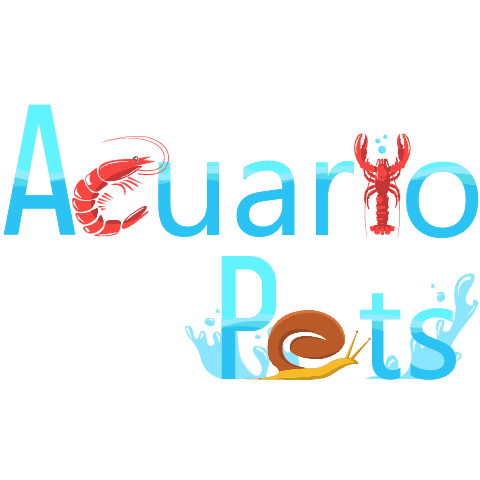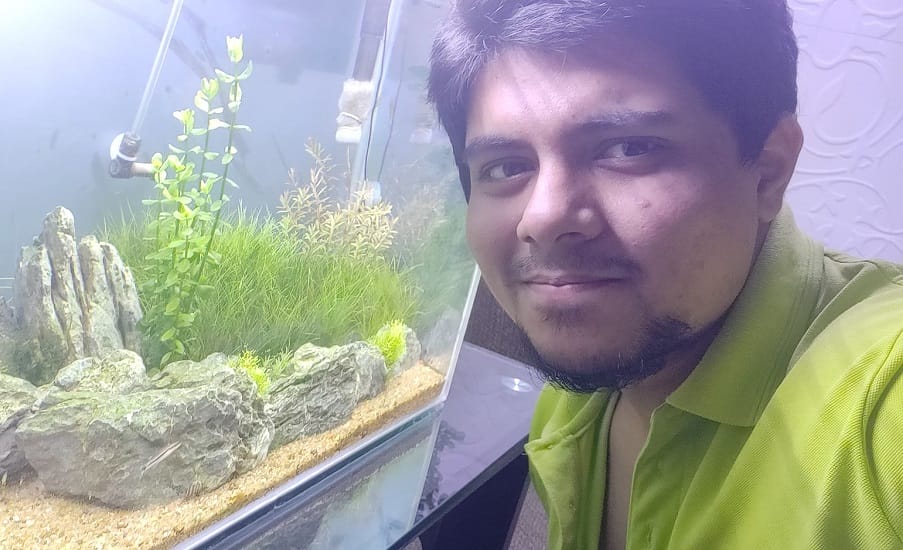This post was created with help from AI tools and carefully reviewed by a human (Muntaseer Rahman) . For more on how we use AI on this site, check out our Editorial Policy.
Check Out These FREE Tools We Made JUST For You!
How to Feed Betta Fish: Complete Schedule, Portions & Food Chart
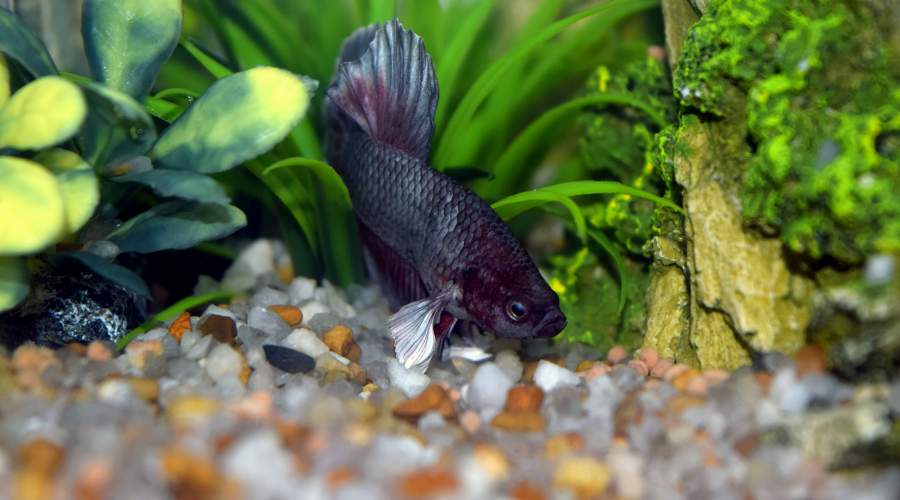
Feed adult bettas 2-4 pellets twice daily (morning and evening), with one fasting day per week. The best foods are high-quality betta pellets (NorthFin, Fluval Bug Bites) with frozen treats like bloodworms 2-3 times per week.
The most common mistakes are overfeeding (bettas’ stomachs are the size of their eyeball), using flake food, and not soaking pellets before feeding. These cause bloating, swim bladder issues, and poor water quality.
This guide covers the best pellet brands, exact portions by size, a printable feeding schedule, and what to do when your betta stops eating. Whether you’re a new owner or fixing past mistakes, you’ll know exactly what and how much to feed.
Quick Betta Feeding Guide:
- How much: 2-4 pellets, twice daily
- When: Morning + evening (consistent times)
- Fasting: One day per week (aids digestion)
- Best foods: Betta pellets, bloodworms, brine shrimp
- Never feed: Flakes, goldfish food, human food
- Pro tip: Soak pellets 15-30 seconds before feeding

What to Feed a Betta Fish
Not all fish food is made equal—especially when it comes to bettas. These little guys aren’t goldfish.
They’re carnivores, and they’ve got high standards. If you feed junk, you’ll get problems like bloating, poor color, and even organ damage over time.
Let’s break down what actually works.
| Food Type | Examples | How Often | Notes |
|---|---|---|---|
| High-Quality Pellets | NorthFin Betta Bits, Fluval Bug Bites, Hikari Bio-Gold | Daily (main food) | Look for whole fish/insect protein as first ingredient. Avoid fillers. |
| Frozen Foods | Bloodworms, brine shrimp, daphnia, mysis shrimp | 2–3 times per week | Thaw before feeding. Use as treats, not daily meals. |
| Live Foods | Mosquito larvae, daphnia, fruit flies, blackworms | 1–2 times per week | Only use clean, safe sources. Adds stimulation and enrichment. |
| Occasional Extras | Spirulina, nori (seaweed) | Once a week (optional) | Not essential. Some bettas ignore it. |
| Foods to Avoid | Flakes, goldfish food, plant-based fillers, random human food | Never | Can cause bloating, poor health, and dirty water. |
High-Quality Betta Pellets
Start with a good pellet made just for bettas. Don’t grab the generic flakes or random tropical fish food.
Here’s what to look for:
- Protein should be the first ingredient, ideally from whole fish or insects.
- Avoid fillers like wheat, soy, and anything ending in “meal.”
- Small pellet size is key—bettas have tiny mouths and short digestive tracts.
Some pellets even float to mimic bugs on the water, which makes it more natural for your fish to eat.
Here are some of the brands I’ll recommend:
1. NorthFin Betta Bits

Check latest price on amazon
- First ingredient: whole krill
- No fillers, no junk
- Small, easy-to-digest size
- Slightly pricey, but worth it
2. Fluval Bug Bites (Betta Formula)

Check latest price on amazon
- Made with black soldier fly larvae
- Great protein source
- Also has salmon and essential vitamins
- Good choice if you want variety in one jar
3. Hikari Betta Bio-Gold

Check latest price on amazon
- Widely available and affordable
- Decent quality, but does have some fillers
- Still better than generic brands
- Use with occasional variety for balance
4. Omega One Betta Buffet Pellets

Check latest price on amazon
- Whole salmon and shrimp up top
- No fish meal
- Boosts color and fin growth
- Tends to sink fast—some bettas ignore it
Frozen or Live Foods
Want to level up their diet and keep them excited? Mix in frozen or live treats a few times a week.
Good options include:
- Bloodworms
- Brine shrimp
- Daphnia
- Mosquito larvae
- Mysis shrimp
- Fruit flies (yes, really)
These are packed with protein and give your betta something to chase. If you’re squeamish about live bugs, go with frozen—they’re easier to portion and store.
But don’t feed this stuff daily. Use it like a treat, not the main meal.
What About Veggies?
Some people throw in spirulina or tiny bits of nori (dried seaweed). It won’t hurt, but bettas don’t need plant food.
If you want to try it, offer a tiny amount once a week, and see if your betta even touches it. Most don’t care.
What to Avoid
Here’s the junk list:
- Flake food
- Anything made for goldfish or general “tropical fish”
- Pellets with mostly grain or soy
- Human food (yes, people try this)
Feeding the wrong stuff doesn’t just affect health—it makes your tank messier too.
Bottom line?
Stick to betta-specific pellets as your main food, and use frozen or live treats for variety. That’s all your fish really needs to stay healthy and active.

How Much to Feed a Betta
There’s no one-size-fits-all number here—but there is a simple rule: don’t feed with your eyes, feed with your fish.
Bettas have small stomachs—about the size of their eyeball. It’s easy to overdo it, especially with pellets.
General Feeding Amount
- 2 to 4 pellets per meal, once or twice a day is the safe range for most adult bettas.
- For king or giant bettas, you can bump it up to 4 to 6 pellets, but only if they’re active and not showing signs of bloating.
Always check the pellet size. Some brands pack more food into each pellet. If they’re large, go with fewer.
For Frozen or Live Food
Frozen bloodworms, brine shrimp, or daphnia? The rule changes a bit.
Feed what your betta can eat in under 2 minutes, or until you see a slight belly curve—not a round ball.
If they’re gulping and then spitting out food, you’ve gone overboard.
Watch the Belly, Not the Clock
Your best guide? The betta’s body.
A healthy feeding will leave a gentle curve in the belly—not a bulge. If the belly looks flat, increase slightly. If it looks swollen, cut back fast.
Bonus Tip: Soak Your Pellets
Dry pellets can expand inside the stomach, causing bloating or even swim bladder issues.
Soak them in tank water for 15–30 seconds before feeding. It makes digestion easier and lowers the risk of constipation.

How Often to Feed (Feeding Schedule)
Bettas don’t graze like goldfish. They need structure. If you keep it consistent, they stay healthy, active, and less prone to digestive issues.
Once or Twice a Day Works Best
- Once a day is fine if you’re using high-quality pellets and your fish isn’t too active.
- Twice a day (morning and evening) gives better energy balance and mimics natural feeding.
Example schedule:
- Morning: 2–3 pellets or a small frozen portion
- Evening: 2 pellets or a tiny treat (like a bloodworm)
Keep portions small. Don’t double up just because you feed twice.
Add a Fasting Day
Give your betta one day off from food every week. No, it’s not cruel—it actually helps.
It clears out the gut, lowers bloating risk, and resets appetite. Pick a day and stick to it.
Adjust for Tank Temperature
If your tank runs cool (below 76°F), your betta’s metabolism slows down. Feed less and possibly only once a day.
If it’s warm (78–80°F), digestion speeds up. Twice-a-day feeding makes more sense.
Don’t Fall for the “Begging”
Bettas act hungry even when they’re full. They’ll come to the glass and beg like they haven’t eaten in days.
Stick to your schedule. You’re the brain here—they’re just fish.
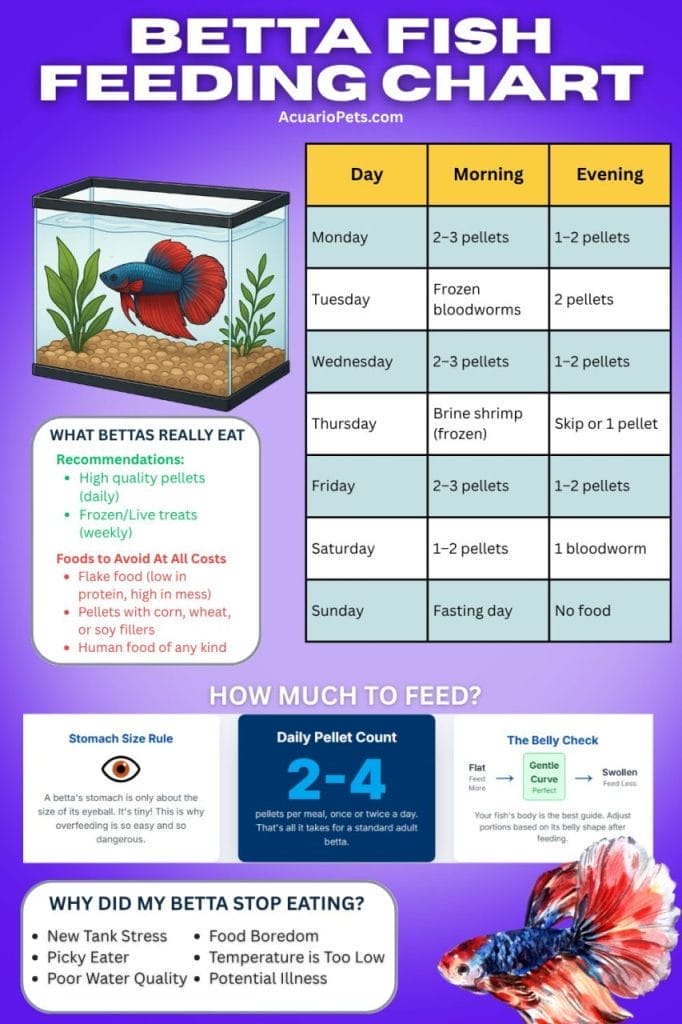
Printable Betta Fish Feeding Chart
| Day | Morning | Evening | Notes |
|---|---|---|---|
| Monday | 2–3 pellets | 1–2 pellets | Observe belly size after feeding |
| Tuesday | Frozen bloodworms | 2 pellets | Treat day—don’t overdo it |
| Wednesday | 2–3 pellets | 1–2 pellets | Soak pellets before feeding |
| Thursday | Brine shrimp (frozen) | Skip or 1 pellet | Light feeding day |
| Friday | 2–3 pellets | 1–2 pellets | Check water quality too |
| Saturday | 1–2 pellets | 1 bloodworm (optional) | Watch for bloating signs |
| Sunday | Fasting day | No food | Rest day for digestion |
- Adjust pellet count based on your betta’s size and activity
- Switch up the frozen foods (bloodworms, brine shrimp, daphnia)
- Use Sunday as a consistent no-feed day
Why Betta Fish Stop Eating
Your betta skipping a meal isn’t always a red flag—but if it drags on, you need to step in. Let’s go through the usual suspects.
1. New Tank = No Appetite
If you just brought your betta home or changed tanks, don’t panic. Many bettas refuse food for a few days while they settle in. It’s normal.
Just keep offering small amounts and give it time.
2. They’re Just Picky
Some bettas turn their nose up at certain pellet brands or food textures. Try:
- Smaller pellets
- Soaking pellets
- Switching to frozen foods for a few days
If they’re eating bloodworms but not pellets, you’ve got a spoiled little prince on your hands.
3. The Food Is Too Big or Too Hard
This is more common than you’d think. Bettas will often take a pellet, chew it, and spit it back out if it’s too hard or oversized.
Soak pellets in tank water before feeding. Or crush them up a bit.
4. They’re Bored of the Same Food
Yes, even fish get bored. If you’ve been feeding the same thing for weeks, they might just be over it.
Alternate pellets with frozen treats like brine shrimp or daphnia once or twice a week.
5. The Water Is Trash
Poor water quality = zero appetite.
Check for:
- Ammonia or nitrite spikes
- High nitrate levels
- Low temperature (below 76°F makes them sluggish)
Fix the water first. Don’t force food while they’re stressed.
6. They’re Actually Sick
If your betta’s also acting weird—like clamped fins, no swimming, or lying at the bottom—this isn’t just about food anymore.
Lack of appetite + weird behavior = possible illness (like parasites, bacterial infection, or swim bladder trouble). Time to isolate, test water, and start researching symptoms.
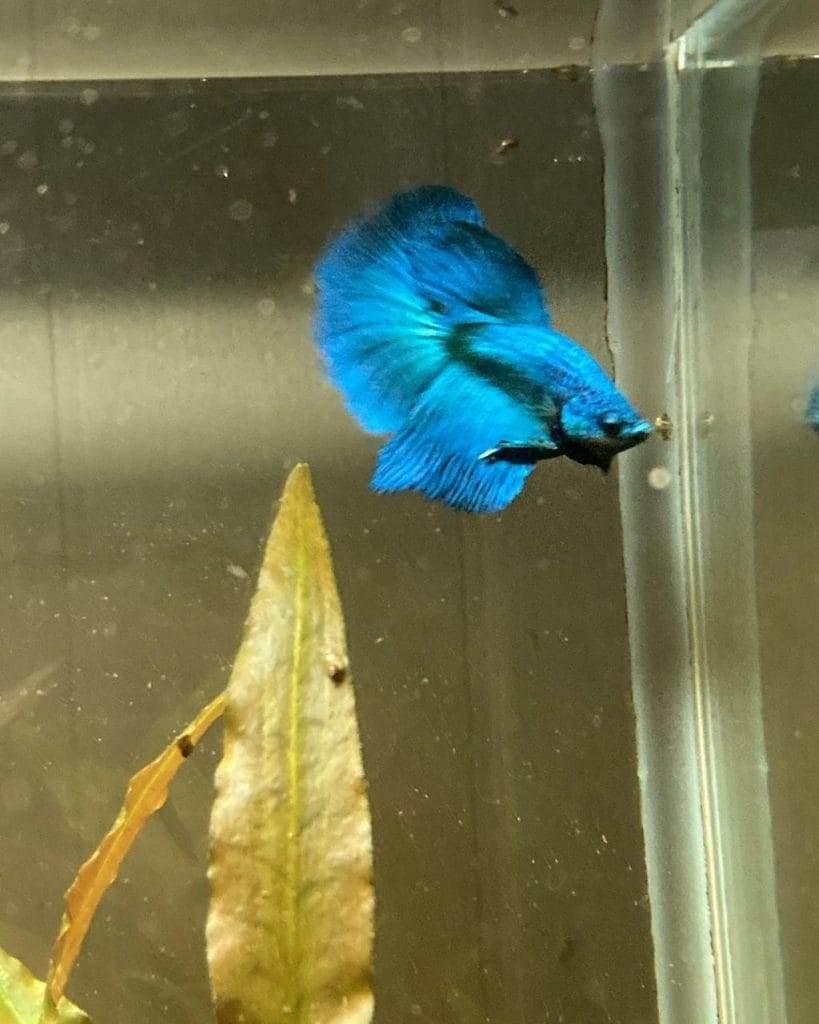
Pro Feeding Tips From Betta Owners
You can follow every label on the jar and still mess up. These tips come from people who’ve been through it and figured out what works.
1. Watch the Belly, Not the Clock
- Don’t just feed based on time. Look at your betta’s body.
- Slight curve = fed just right.
- Round belly = too much.
- Sunken belly = needs a bit more.
2. Soak Dry Pellets
Always soak pellets in tank water for 15–30 seconds before feeding.
Dry ones expand in the stomach and can cause bloating or swim bladder issues.
3. Rotate the Food
One day pellets. Another day frozen brine shrimp.
Change it up to keep your betta interested and healthy. Same food every day = boredom and possible refusal.
4. Don’t Feed from the Jar
Use a spoon, tweezers, or a separate dish. Feeding straight from the container usually ends in overfeeding.
5. Stick to a Schedule, Then Break It (on Purpose)
Feed at the same times every day—but don’t forget the weekly fasting day. It keeps digestion smooth and helps prevent health problems.
6. Clean Up Leftovers Fast
Uneaten food rots fast and messes up water quality. If your betta ignores food for more than 5 minutes, pull it out.

Frequently Asked Questions
Can I skip a feeding if I’m busy?
Yes. Skipping one meal won’t hurt your betta. Just don’t make it a habit.
Should I feed my betta at night?
Not ideal. Bettas are more active during the day. Stick to mornings and early evenings.
Can I feed both pellets and frozen food in the same day?
Absolutely. Just keep the portions small. Don’t double the total amount.
How long can a betta go without food?
A healthy adult betta can survive up to 10–14 days without food, but it’s not recommended. Missing a day or two is fine. Beyond that, it’s a problem.
Can I give my betta human food?
Nope. Don’t do it. Their digestive system isn’t built for it, and you could make them sick.
My betta begs for food all day. Should I give in?
No. Bettas are great actors. Stick to your schedule—they’re not starving, just dramatic.
About Author
Hello, I’m Muntaseer Rahman, the owner of AcuarioPets.com. I’m passionate about aquarium pets like shrimps, snails, crabs, and crayfish. I’ve created this website to share my expertise and help you provide better care for these amazing pets.
Disclaimer
This site is owned and operated by Muntaseer Rahman. AcuarioPets.com is a participant in the Amazon Services LLC Associates Program, an affiliate advertising program designed to provide a means for sites to earn advertising fees by advertising and linking to Amazon.com. This site also participates in other affiliate programs and is compensated for referring traffic and business to these companies.
